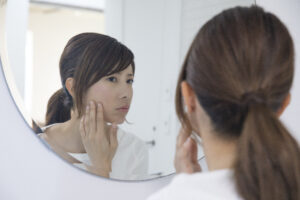By Iris Farrou
21 Mar, 2021
Menstruation
Best gyns in Buffalo, Best OB practices in Buffalo, Best OBGYN Groups in Buffalo, Buffalo OB-GYN, Buffalo OBGYN, Chouchani MD, Normal menstruation cycle, WNY OB-GYN, WNY OBGYN, women's health tips

When your doctor asks when your last cycle was, there’s no need to jog down memory lane, as you can simply open an app on your smartphone. Cycle tracking apps are helpful with everything from monitoring mood and fertility to alerting us of reproductive system illnesses. If you search for “period tracker” in your app store, the 50+ choices can seem overwhelming.
Here’s a list of favorite cycle tracking apps:
Clue Period & Cycle Tracker
Clue has been accredited by the Obstetrics & Gynecology Journal (ACOG) as the Top Free Period Tracking App, the Best Fertility App by Healthline, and App of the Day Worldwide by the Apple App Store. Clue is female-led and doctor recommended. It lets you log cramps, mood fluctuations, sex drive, sleep schedule, food cravings, and over 30 other categories. The more consistently you log your cycle, the more accurately the app predicts your body’s rhythm. It also alerts you when certain changes or fluctuations may indicate a health issue. Clue’s custom push notifications notify you with shocking accuracy to events like the beginning of your cycle, ovulation, and PMS.
Life – Period Tracker Calendar
This sleek app integrates with HealthKit, allowing you to synchronize your custom data with your phone’s Health App. You can track nutrition, fitness, moods, weight, medication, and more in the most customizable app available. Life also integrates irregular cycle support and allows you to keep separate entries for each symptom so as to easily share it with your physician at a later time. Additionally, you can prevent false alerts about irregularities that may not concern you by personalizing your cycle length. Life is backed and used by licensed physicians, gynecologists and has over 50,000 glowing reviews.
Glow Period and Fertility Tracker
Glow is modern care for your fertility, plus tracking for over 40 different biological symptoms. “Glow Scoops,” a resource section built into the app, has an expansive library of informational articles on topics like egg freezing and menstrual health. You can also export custom PDF reports of your ovulation or fertility health charts to simplify the pregnancy process, and join support communities for issues like IVF, IUI, and natural pregnancy. Glow has a team-based mentality, including generating personal data that your medical care professionals can use to better know your body, and diagnose health issues early and efficiently.
Eve Tracker App
With a recently redesigned Cycle Chart, Eve is a savvy period tracker and sex app for women looking to take control of their health and sex lives. Eve is a spicier type of tracking app that includes the typical interactive tracking data, and also has daily sex quizzes so you can own your cycle and feel good in bed. The interactive staircase helps you see your menstrual history in a new light and has a community of women that discuss sex and health issues. Eve is also compatible with the Health app and has an interactive calendar view for every step of your cycle.
More
By Iris Farrou
19 Mar, 2021
Queer Health, Sexual health, Women's Health
Best gyns in Buffalo, Best OB practices in Buffalo, Best OBGYN Groups in Buffalo, Buffalo OBGYN, Chouchani MD, queer health, WNY OB-GYN, WNY Ob-gyn doctors, women's health

Many of the gynecological health issues associated with heterosexual women are also concerns of queer women, including homosexual and bisexual women. However, because queer women are not generally concerned with mainstream gynecological health issues, such as pregnancy and contraception, they may find it difficult to receive adequate support from healthcare professionals, or access unbiased and non-discriminatory resources. It should also not be forgotten that minority populations tend to experience higher levels of social anxiety, stress, and depression. As such, the higher levels of mental healthcare that queer women need, along with the lack of resources targeted specifically to them, places them at a precarious position when it comes to sexual and gynecological health.
Gynecological Care Tips
While the following tips and areas of concern to be noted may not apply to everyone, as sexual health depends on sexual preferences, family history, overall health, and health among other factors, these have been identified as the most common areas of concern among queer women.
- Bacterial Vaginosis: Lesbian women that seek care for bacterial vaginosis at women’s health clinics have been found to be twice the rate compared to heterosexual women. Bacterial vaginosis has been found to be associated with a higher number of female sexual partners, though its transmission mechanism is only hypothesized to be oral sex.
- Yeast Infection: Though not identified as a sexually transmitted infection, yeast infections can occur through direct skin contact with someone who harbors the organism. As far as lesbian sexual relations are concerned, this transmission may occur due to vulva-to-vulva connection, or through the transmission of the bacteria from the fingers to the vagina.
- Herpes, HPV, Hepatitis: Common as these are, they are also present in queer women’s intimate relationships—vaccinations against these infections, as well as practicing safe sex and maintaining personal hygiene and health minimize the risk of contraction.
Mental Health Care Tips
Sexual minorities do not only experience higher levels of stress and depression, but they also experience social discrimination and isolation. This can lead to a conglomeration of mental health issues, but most notably it tends to lead to queer women remaining silent when it comes to domestic abuse and intimate partner violence.
This silence is primarily associated with the general misconception that abuse is present only in heterosexual relationships, and it is also attributed to fear of discrimination. Though the discrimination and the experienced violence may be directly related, as queer women have been found to experience mental, physical and verbal abuse that targets their sexual orientation, it may also be indirect. Lack of training in part of service providers or discrimination in shelters create more difficulties for queer women who seek support against intimate or domestic violence, which in turn leaves them in abusive situations for a longer period of time.
It should also be taken into consideration that the fear of being “outed,” not receiving adequate support from health providers, friends, and family, or the fear of social and intimate isolation are factors that contribute to the higher rates of violence and abuse in queer women’s relationships. If you are experiencing partner violence, consider reaching out for support to a trusted individual, or conducting research on domestic violence support that may assist you in creating a plan to leave the abusive environment.
More
By Iris Farrou
08 Mar, 2021
Heart health
Best gyns in Buffalo, Best OB practices in Buffalo, Best OBGYN Groups in Buffalo, Buffalo OB-GYN, Buffalo OBGYN, Chouchani MD, WNY OB-GYN, WNY Ob-gyn doctors, WNY OBGYN, women's heart health

Though we may be more concerned with heart attacks in general, it is important to remember it is just one condition associated with the umbrella of heart diseases, which may also include coronary artery disease, valve disease, or rhythm problems—among others.
Causes and Symptoms
The cause of a heart disease may depend on one or more of the following risk factors:
- Diabetes: Women with diabetes have higher chances of developing heart disease than men. Additionally, because diabetes changes the way one perceives pain, it also increases the chances of a silent heart attack.
- Stress and depression: In addition to making it difficult overall to have a healthy lifestyle, stress has been found to affect women at a higher percentage than men when it comes to heart health.
- Smoking and inactivity: Undeniably the causes of myriad health problems, smoking and lack of physical activity directly influence heart health in women negatively.
- Menopause: A cause for concern after menopause is the low estrogen levels, which may lead to heart disease in smaller blood vessels.
- Pregnancy complications: Women’s long-term risk of high blood pressure and diabetes may be augmented if such health conditions make themselves present during pregnancy.
- Family history: History of early heart disease appears to be a higher risk factor in women than in men.
Symptoms of heart disease should be taken seriously, and be followed up with consultation with a medical professional, especially as they may resemble day-to-day symptoms of fatigue:
- Pain in the neck, jaw, or throat
- Sharp chest pain or discomfort, but also dull and heavy pain
- Pain in the back or upper abdomen
- Nausea, vomiting, and fatigue
- Indigestion and heartburn
- Chest palpitations
- Shortness of breath and swelling of the feet and ankles
Misdiagnosis
The two main reasons for misdiagnosed heart disease in women is that it is typically thought of as a male problem—despite it being the number one cause of death of American women—and that the symptoms are sometimes dismissed as something less serious.
A study conducted in 2018 found that 62% of women reported more than three symptoms that were not associated with the chest area or with chest pain, compared to 54.8% of men. Additionally, 53% of women in the study confessed to their doctors or health providers dismissing the symptoms as not associated with heart disease. Only 36.7% of men in the study reported their health provider treating their symptoms as something less.
Health Tips
Maintaining your overall health is important in preventing heart disease, but you may want to pay more particular attention to alcohol consumption and smoking, as well as add regular exercise to your routine. Managing and lowering stress levels and depression is also optimal, as is a diet that assists your overall health.
More
By Iris Farrou
26 Feb, 2021
Lifestyle Tips, Sexual health
Best gyns in Buffalo, Best OB practices in Buffalo, Best OBGYN Groups in Buffalo, Buffalo OB-GYN, Buffalo OBGYN, Chouchani MD, WNY OB-GYN, WNY Ob-gyn doctors, WNY OBGYN, women's health

According to the CDC, human papillomavirus (HPV) is the most common sexually transmitted infection (STI), while other sources report that about 14 million people become infected every year. Both men and women can contract HPV. It is estimated that though 80% of sexually active individuals are likely to have it during their life, not all of them know they have the virus. Some types of the virus can cause warts or cancer, while other types go away on their own. However, contracting the disease once does not exclude one from getting it again.
Causes and Transmission
HPV can be transmitted relatively easy when skin on skin contact with someone who has it occurs. Most commonly, this occurs with sexual contact and during vaginal or anal sex. It may also be transmitted during childbirth, from the mother to her baby. In many instances, HPV causes no symptoms, which can make it rather hard to even suspect its presence. Additionally, if you have contracted the virus it can take years to show any symptoms so identifying when you first became infected becomes a challenge. The most common symptom is warts, which are usually bumps in the genital area—either flat or raised. In other cases, when the virus does not go away it can cause different types of cancer.
It is recommended that you not only get tested regularly for STIs, and keep up with Pap smears, but that you also specifically request an HPV test. Regular Pap smear results do not exclude the possibility of HPV; in ages over 30, you may also want to consider screening for cervical cancer.
HPV and Cancer
Like with other symptoms of HPV, it can take many years after it is contracted to form into a type of cancer. Usually, the virus causes cervical cancer but it can also cause cancer of the vulva, penis, or anus. It may also cause oropharyngeal cancer, which is located at the back of the throat, base of the tongue and tonsils.
Though there is no cure for HPV itself, there are treatments for warts and for different types of cancer. The most usual treatments for women include colposcopy, where the cervix is closely examined for pre-cancerous cells, cryotherapy which freezes and removes pre-cancerous cells from the cervix, and Loop Electrosurgical Excision Procedure (LEEP) the removes the pre-cancerous cells using an electrical current.
HPV Prevention and Vaccine
Similar to the prevention of any STI, limited sexual contact, safe sexual practices, and regular health checks are good measures to stay safe. The HPV vaccine, however, increases chances of preventing warts and cervical cancer caused. Though the HPV vaccine recommended age is 11 to 12 years old and before the existence of sexual contact, it is still possible to get the vaccine even if you are sexually active already. Remember that the HPV vaccine does not protect against all types of cervical cancer and in most cases it is given in three separate shots.
More
By Iris Farrou
20 Feb, 2021
Women's Health
Best gyns in Buffalo, Best OB practices in Buffalo, Best OBGYN Groups in Buffalo, Buffalo OBGYN, Chouchani MD, WNY OB-GYN, WNY Ob-gyn doctors, WNY OBGYN, women's health, women's health tips


 Polycystic ovary syndrome is a common health condition marked by irregular periods, or no menstruation at all. It is more common among women of childbearing age, but not exclusively. PCOS causes multiple cysts to appear in the ovaries, usually due to the overproduction of androgens. The most usual symptoms of PCOS are excessive hairiness, acne, and male pattern baldness. If symptoms go untreated, women with PCOS are at greater risk for heart disease, endometrial cancer, high blood pressure, and diabetes. It causes significant problems with weight gain and weight management, so diet tips and awareness are optimal if you have PCOS.
Polycystic ovary syndrome is a common health condition marked by irregular periods, or no menstruation at all. It is more common among women of childbearing age, but not exclusively. PCOS causes multiple cysts to appear in the ovaries, usually due to the overproduction of androgens. The most usual symptoms of PCOS are excessive hairiness, acne, and male pattern baldness. If symptoms go untreated, women with PCOS are at greater risk for heart disease, endometrial cancer, high blood pressure, and diabetes. It causes significant problems with weight gain and weight management, so diet tips and awareness are optimal if you have PCOS.
Insulin is a hormone produced in the pancreas and it helps with transforming sugar into energy. Women with PCOS have been found to have higher than normal insulin levels, and their bodies tend to not use the insulin produced effectively. This is known as being “insulin resistant,” where the body tries to keep insulin levels normal by producing even more insulin. Higher levels of insulin, however, cause the ovaries to produce more androgens—such as testosterone. Insulin resistance also makes it harder to lose weight, hence the challenge women with PCOS face.
PCOS and Diet
Though there is no one fit-all diet for women with PCOS, there is a general consensus agreeing that a diet high in refined carbohydrates doesn’t help anyone. Foods in a low glycemic index—such as legumes, nuts, seeds, fruits and other foods that are low-carbohydrates—and anti-inflammatory foods—such as berries, fatty foods, leafy greens—help with weight management.
To combat insulin resistance, consider adding the following high-fiber foods to your diet:
- broccoli
- cauliflower
- Brussels sprout
- red leaf lettuce
- arugula
- bell peppers
- beans
- lentils
- sweet potatoes
- pumpkin
- winter squash
To reduce inflammation, opt for a diet high in:
- kale
- tomatoes
- spinach
- almonds
- walnuts
- berries (especially blueberries and strawberries)
- fatty fish (salmon and sardines)
- olive oil
Other healthy dietary options include lean protein sources like tofu and chicken.
As with any medical issue, there is no one recipe for success; consult with your doctor or a medical professional if you need further assistance concerning your diet when diagnosed with PCOS.
More
By Iris Farrou
09 Feb, 2021
Menstruation
Best gyns in Buffalo, Best OB practices in Buffalo, Best OBGYN Groups in Buffalo, Buffalo OB-GYN, Buffalo OBGYN, Chouchani MD, skincare, WNY OB-GYN, WNY Ob-gyn doctors, WNY OBGYN, women's health
 It’s not a secret that menstrual cycles causes all sorts of changes to our bodies, our moods, our hair, etc, but our cycle also brings about changes to our skin. You may be surprised to find out it’s not only during menstruation and the frequent breakout that accompanies it that our hormones are at work. In fact, estrogen, progesterone, and testosterone work hard throughout our menstrual cycle to ensure that they are causing changes to our skin. You can check the best laser hair removal in Las Vegas, NV and know where to go to get a glow up.
It’s not a secret that menstrual cycles causes all sorts of changes to our bodies, our moods, our hair, etc, but our cycle also brings about changes to our skin. You may be surprised to find out it’s not only during menstruation and the frequent breakout that accompanies it that our hormones are at work. In fact, estrogen, progesterone, and testosterone work hard throughout our menstrual cycle to ensure that they are causing changes to our skin. You can check the best laser hair removal in Las Vegas, NV and know where to go to get a glow up.
Shark Week
During our periods, and especially on the first day, all our hormones are at their lowest levels. You may have noticed not only the breakouts but also the lack of moisture—this is due to the low sebum production. It is ideal to consume more water to help your skin retain hydration, and to use a moisturizer or serum high in hyaluronic acid. Increased pain sensitivity is also noticed during that time, so try to avoid procedures that would be painful (like waxing). For the Top 7 Benefits of CoolSculpting, and the way it benefits the skin, it is best to check out this link!
Venus Week
After menstruation ends, our skin begins the process of producing estrogen anew. You have probably noticed that in the days after your period your skin glows more and may feel more youthful or plump. The increased levels of estrogen mean that collagen, elastin, and hyaluronic acid are created, leading to stronger elastic cells. If you want to help your skin with this turnover process, you can consider exfoliating. It is generally suggested that you use gentle and natural exfoliants and lessen the amount of makeup so that you give your skin a chance to breathe. Lowering your sugar and carb intake during this week will also help your skin glow even more!
Minerva Phase
After ovulation, female bodies pump up the levels of progesterone—the hormone responsible for “watching after” potential pregnancies. This surge leads to more sebum production, swelling of your skin and compression of pores. This is the phase when more oil is likely to be trapped in our skin pores, thus causing the dreaded breakout to commence. You may also feel more bloated during this time, as our metabolism tends to slow down. As far as your skincare routine goes in this phase, you want to ensure that you are using products that help with the excess oil: cleanse with a gentle toner, add a clay mask to your routine, or use spot-on acne treatment for potential blemishes.
Takeaway
Being cognizant of the hormonal changes during your menstrual cycle can certainly help you take better care of your skin, and possibly lessen the personal guilt that comes with blemishes or dry skin! However, there may always be other conditions that cause skin problems so always check with your doctor before drastically changing your skincare routine, or if you are on any medications that might affect it.
More
By Iris Farrou
19 Jan, 2021
Women's Health
Best gyns in Buffalo, Best OB practices in Buffalo, Best OBGYN Groups in Buffalo, Best OBGyn groups WNY, Buffalo OB-GYN, Buffalo OBGYN, celiac disease, celiacs, Chouchani MD, Low libido, WNY OB-GYN

We often hear about the effects gluten intolerance, or even over-consumption of gluten, can have on our health, especially the ways in which gluten can disrupt healthy digestion. What may be less known, however, is how gluten affects our sex drive and therefore may be impacting our overall sexual health. Problems with your libido might be especially present if you are suffering from undiagnosed celiac disease and may not be following the recommended diet.
What is celiac disease?
Celiac disease is an immune disease the destroys the small intestine; you cannot eat gluten if you have celiac disease, because your body’s reaction will be to destroy the small intestine. However, each person may show different symptoms: some people’s digestive system is suffering, while others may be irritable and depressed.
What can celiac disease do to your libido?
Digestion
Celiac can cause bloating, gas, fatigue, and even depression. Though the mental aspect of how celiac may be affecting you is not to be overlooked, as chronic fatigue and depression can certainly have a negative effect on our sex drive, the physical aspect can be just as important. It is worth considering how much stress feeling uncomfortable due to digestive problems can add to your sex life.
Gluten and Hormones
Despite the physical effects of celiac disease, it is important to remember that gluten consumption may also lead to hormonal abnormalities. This is especially true when celiac disease causes malabsorption. Malabsorption can then lead to nutritional deficiencies, which in turn affect your hormones. As a result, your sexual desire—and in some cases performance—may suffer the consequences.
Gluten-Free Diet
If you suspect you may have undiagnosed celiac disease, it is suggested that you book an appointment with your physician to get a diagnosis. As with any medical issue, a self-diagnosis is not the best solution. However, reducing the amount of gluten in your day-to- day life may help with your digestion and possible hormonal imbalances, especially if you may just simply be intolerant to gluten.
It is recommended that you always get a proper diagnosis in collaboration with your doctor, or your primary physician, as a low sex drive may not necessarily be caused by gluten consumption; if there are any other underlying issues, a medical examination will help you resolve them, and it will lead you to a healthy diet that is appropriate for your body’s needs.
More
By Iris Farrou
06 Jan, 2021
Menstruation
Best gyns in Buffalo, Best OB practices in Buffalo, Best OBGYN Groups in Buffalo, Buffalo OB-GYN, Buffalo OBGYN, Chouchani MD, missed period, Normal menstruation cycle, WNY OB-GYN, WNY OBGYN

Irregular or missed periods happen for many reasons besides pregnancy. While most women have a period every 28 days, a healthy cycle can range from 21 to 35 days. So, it’s helpful to keep in mind that normal is relative to each person. There are many other reasons that can cause irregular or missed periods.
Most people have some amount of stress in their daily lives—let’s face it, in a pandemic, who isn’t experiencing some stress? Even with tactics to manage stress (working out, meditation, therapy, healthy eating, etc.), stress can cause physical symptoms, including altering your period. Significant stress can disrupt your hormonal balance, which may lead to delayed, irregular, heavy, or even missed periods.
- Weight loss/Too much exercise
While losing weight is usually good, losing weight too quickly can also affect your hormones. The loss of a hormone in fatty tissue called leptin can lead to the loss of other hormones, including estrogen, which may cause your period to be irregular.
- Low body weight/Eating disorders
Women with eating disorders, such as anorexia nervosa or bulimia, may also experience missed or irregular periods. In fact, women may stop ovulating if they weigh 10% below the normal range for their height. Gaining weight usually triggers the body to return to normal ovulation, but eating disorders are serious. Seeking medical help is imperative.
- Polycystic ovary syndrome (PCOS)
Affecting about 5% to 10% of women, PCOS is a medical condition caused by an imbalance of reproductive hormones. With an imbalance of estrogen, your period could come more or less frequently than normal.
Going on or off birth control may affect your cycle right away or even months later. Birth control pills contain hormones, estrogen and progestin, which stop your ovaries from releasing eggs. In fact, low-estrogen birth control pills, IUDs, and shots can even trigger a light or non-existent period. It may take up to three months for a period to return to normal after a women goes off birth control.
In addition to causing weight gain or weight loss, thyroid disorders can affect hormones, leading to irregular or missed periods. The thyroid regulates the body’s metabolism, which can alter hormone levels.
If you experience an irregular period with other symptoms (fever, severe pain, unusually heavy bleeding, etc.), you should contact your doctor right away. Otherwise, keeping a log of your period can help your doctor diagnose the issue.
More
By Iris Farrou
30 Dec, 2020
Pregnancy
Best gyns in Buffalo, Best OB practices in Buffalo, Best OBGYN Groups in Buffalo, Buffalo OBGYN, Chouchani MD, Healthy pregnancy, WNY OB-GYN, WNY Ob-gyn doctors, WNY OBGYN, women's health
 There comes a time at every pregnancy when the delivery of the baby becomes the issue at hand; many mothers have a choice on whether to go through a natural birth—also referred to as vaginal birth—or request a Caesarian section, most commonly known as C-section. Sometimes a C-section is necessary, especially in cases of medical concerns for the health of the baby or the mother, but when faced with the option it is a wise idea to be informed of the differences between the two methods of delivery, as well as their respective risks and complications.
There comes a time at every pregnancy when the delivery of the baby becomes the issue at hand; many mothers have a choice on whether to go through a natural birth—also referred to as vaginal birth—or request a Caesarian section, most commonly known as C-section. Sometimes a C-section is necessary, especially in cases of medical concerns for the health of the baby or the mother, but when faced with the option it is a wise idea to be informed of the differences between the two methods of delivery, as well as their respective risks and complications.
Overview
C-sections are a surgical procedure to deliver the newborn, and it takes place either when requested by the mother in lieu of natural birth, or when medical conditions make it necessary. Sometimes a C-section is pre-planned, while other times it may become necessary during labor. They are not as common as natural births, but the following conditions may make a C-section necessary for the safety of both the mother and the baby:
- General health medical concerns for the newborn
- Delivery of more than one baby
- Maternal infections or conditions, such as diabetes
- Problems with the placenta
- Delivery of a larger baby
- A labor that is not progressing in a timely manner, making it unsafe to continue naturally
A natural birth is a vaginal delivery, and it may take place with or without medical assistance for the pain. Natural births usually require a shorter hospital stay and have a faster recovery period. If the mother chooses to have a medical intervention to assist with a natural birth, this may be one of the following:
- Using Pitocin to induce labor
- An incision to help with the delivery of the baby without tearing the skin
- Artificially breaking the water, which would mean a rupture of the amniotic membrane
- A vacuum extraction
Procedure and Healing
Caesarean Delivery
In the case of a Caesarean section, the surgical procedure in general takes about 45 minutes. An incision is made through your abdomen and uterus to remove the baby, usually in the lower part of your uterus. As it is an operation, mothers may be given general anesthesia or an epidural block, where you will be awake during the procedure but not feel the lower part of your body.
The doctor cuts the umbilical cord, removes the placenta and closes the incision while the nurses may need to check the baby and clear their airway before they return it to the mother. Unlike natural birth, it may be a few minutes before the mother is united with her baby after a C-section.
As it is a surgery, recovering from a C-section will be similar to that of any kind of operation. There is a two to four day required stay at the hospital, and pain is to be expected when moving around or getting in and out of bed. The scar from the procedure may be itchy or painful in the first few weeks, like with any surgical scar, and cramps or discharge for about four to six weeks are natural.
Vaginal Delivery
A vaginal delivery happens in the hospital or a birthing center, and sometimes at home. In some cases, mothers opt for an epidural to numb the pain. There are three stages to this procedure: early, active, and transitional. Periodically, your cervix will be measured to determine whether you are fully dilated.
A full dilation is when the cervix is at 10 cm, when it is time to push. As the baby moves down the birth canal, the medical team assists with the delivery and uniting the newborn with the mother immediately. While the baby may be out, more contractions to extract the placenta are expected. Unlike a C-section, natural delivery has no specific timeframe and may take hours.
Takeaway
When the time comes to consider the safest option for you and your baby, always consult with your medical professional or your doctor. The safest choice depends on your medical history.
More

Though the word “mammogram” may ring as scary for many women, it is essentially an X-ray imaging of your breasts to detect a tumor or other abnormalities. There is no suggested or ideal age at which medical professionals agree one should start getting a screening mammogram, but typically women get their first mammogram between ages 35 and 40. Depending on risk level and preferences, women should discuss the options and risks with their doctor.
Remember that getting a screening mammogram does not necessarily mean there is cancer present: even if you get a call back, which is most common in first mammograms, it is most likely to look at a certain area more carefully. An extra ultrasound may be more commonly required in women who are pre-menopausal and get a mammogram done.
Facility Tips
- Choose a facility that specializes in mammograms and conducts a number of them in a day, speaking to its credibility and expertise. To reassure yourself about the standards being met, you may request to see an FDA certificate. If possible, visit the same facility every year so that your record is kept and comparisons may be done easily.
- Get your records from any other facility you may have visited in the past, so the pictures can be compared, and you can save some time.
- Also bring with you a list of places and dates when other mammograms may have been done, as well as biopsies or other breast treatments.
Day of the Mammogram
- Avoid deodorant, cream, or powder under your arms on the day you are scheduled to have a mammogram as those substances may show up as white spots.
- Wear clothes that will make it easy to remove just the top and your bra on the day of the exam.
- Try to schedule the mammogram on a day when your breasts are not swollen, so as to get a better picture and be more comfortable.
The Exam
- Most technologists are women, and you and the technologist should be the ones in the room during the exam. They will position your breasts accordingly for the mammogram.
- Expect your breasts to be compressed between two plates, and the procedure should take about 10-20 minutes, while the breast compression will not be more than a few seconds.
- For a screening mammogram, two views of each breast are required. For women with larger breasts or breast implants, more photos may be necessary.
- There may be some discomfort or pain during the procedure, but you should alert the technologist so they can try and make it more comfortable for you.
Though getting a mammogram does not necessarily mean you have a malignant lump or cancer, you should check with the facility if you don’t hear back from them—until you are certain, you should not assume the mammogram is normal. The best quality of a mammogram is that it can detect breast cancer even if it is too small to be felt; this means that it is diagnosed at a very early stage giving it the best chances at a successful treatment.
More










